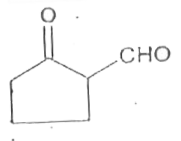S1: C2H5OH & AgCN can form nucleophile
S2: AgCN & KCN can form nitrile nucleophile in all reaction conditions
Both S1&S2 are correct
S1 is correct & S2 is wrong
S2 is correct & S1 is wrong
Both S1&S2 are wrong
Step by step video & image solution for S_1: C_2H_5OH & AgCN can form nucleophile S_2: AgCN & KCN can form nitrile nucleophile in all reaction conditions by Chemistry experts to help you in doubts & scoring excellent marks in Class 12 exams.
Updated on:21/07/2023Similar Questions
Give below are two statements:
Statement I : C2H5OH and AgCN both can generate nucleophile.
Statement II : KCN and AgCN both will generate nitrile nucleophile with all reaction conditions.
Choose the most appropriate option.
View SolutionAldehydes and ketones are amphoteric. Thus they can act both as acids and bases. Under acidic conditions, the carbon of the protonated canbonyl group is much more electrophilic, reacting even with weak nucleopphilie. Carbonyl compound gives nucleophilic addition reaction. In this reaction the nucleophilic attack proceeds the elecrophilic attack.
Carbonyl compounds gives nucleophilic addition with
View Solution
Knowledge Check
H2S can form
Afour series of saltBtwo series of saltConly one series of saltsDthree series of saltC2H5OH and C6H5OH can be distinguished by
ABr2+H2OBI2+NaOHCFeCl3DBoth b and cEster given nucleophilic addition reaction followed by elimination reaction with carbon nucleophile . When carbon nucleophile is of an ester then the reaction is know as Claisen condensation reaction. This reactions is also carrie out between ester and a ketone. A successful Claisen condensation requires an ester with two α - hydrogens and a an equivalent amount of base rather than a cataytic amount of base .
In the give reaction .
C2H5O−O∣∣C−(CH2)5−CH2−COOC2H5(i)C2H3ONa/C2H5OH−−−−−−−−−−−−−−→(ii)H2O/HCl[X] [X] is .A B
B C
C D
D
Aliphatic nucleophilic substitution is mainly of two type SN1 and SN2.SN2 reaction proceed with strong nucleophile in polar aprotic solvent. 3∘ halides do not give SN2 reaction. Inverted products are obtained in this reaction and mechanism of reaction occurs through the formation of transition state.
SN1 reaction proceed through the formation of carbocation in polar aprotic solvent. Solvent itself acts as nucleophile in this reaction. Racemization takes place in SN1 reaction.
Which one of the following will give racemised product in C2H5OH?
View SolutionAn alkyl halide with β-hydrogen atoms on reaction with a base or a nucleophile has two competing paths. Substitutions (SN1 and SN2) and elimination (E1 and E2). The path adopted by them depends upon the nature of the alkyl halide, strength and size of the base/nucleophile and reaction conditions. The bulkiers nucleophile prefers to act as a base and abstracts a proton rather than approaching a tetravalent carbon atom (due to steric reasons) and vise versa. A primary alkyl halide can react by any of the four mechanism (SN2,SN1,E2 and E1) depending upon the stability or the intermediate carbocation or the substituted alkene formed and the reaction conditions and tertiary alkyl halide. The three possible paths (SN1,E1 and E2)
2-Bromopentane is heated with potassium ethoxide in ethanol. The major product obtained is
View SolutionAn alkyl halide with β-hydrogen atoms on reaction with a base or a nucleophile has two competing paths. Substitutions (SN1 and SN2) and elimination (E1 and E2). The path adopted by them depends upon the nature of the alkyl halide, strength and size of the base/nucleophile and reaction conditions. The bulkiers nucleophile prefers to act as a base and abstracts a proton rather than approaching a tetravalent carbon atom (due to steric reasons) and vise versa. A primary alkyl halide can react by any of the four mechanism (SN2,SN1,E2 and E1) depending upon the stability or the intermediate carbocation or the substituted alkene formed and the reaction conditions and tertiary alkyl halide. The three possible paths (SN1,E1 and E2)
Neopentyl bromide undergoes dehydrohalogenations to give alkene though it has no β-hydrogen. This is due
View SolutionAn alkyl halide with β-hydrogen atoms on reaction with a base or a nucleophile has two competing paths. Substitutions (SN1 and SN2) and elimination (E1 and E2). The path adopted by them depends upon the nature of the alkyl halide, strength and size of the base/nucleophile and reaction conditions. The bulkiers nucleophile prefers to act as a base and abstracts a proton rather than approaching a tetravalent carbon atom (due to steric reasons) and vise versa. A primary alkyl halide can react by any of the four mechanism (SN2,SN1,E2 and E1) depending upon the stability or the intermediate carbocation or the substituted alkene formed and the reaction conditions and tertiary alkyl halide. The three possible paths (SN1,E1 and E2)
Isopropyl bromide on heating with a concentrated solution of alcoholic (ethanolic) KOH predominantly gives
View SolutionAliphatic nucleophilic substitution is mainly of two type SN1 and SN2.SN2 reaction proceed with strong nucleophile in polar aprotic solvent. 3∘ halides do not give SN2 reaction. Inverted products are obtained in this reaction and mechanism of reaction occurs through the formation of transition state.
SN1 reaction proceed through the formation of carbocation in polar aprotic solvent. Solvent itself acts as nucleophile in this reaction. Racemization takes place in SN1 reaction.
Which one of the following will give SN2 reaction?
View Solution
